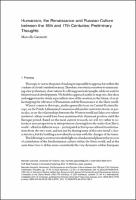Chapter Humanism, the Renaissance and Russian Culture between the 15th and 17th Centuries: Preliminary Thoughts
| dc.contributor.author | Garzaniti, Marcello | |
| dc.date.accessioned | 2022-06-01T12:14:37Z | |
| dc.date.available | 2022-06-01T12:14:37Z | |
| dc.date.issued | 2020 | |
| dc.identifier | ONIX_20220601_9788855181983_316 | |
| dc.identifier.issn | 2612-7679 | |
| dc.identifier.uri | https://library.oapen.org/handle/20.500.12657/56133 | |
| dc.description.abstract | This study offers a synthetic view of the relationship of the Eastern Slavic world, in particular Russia, with Humanism and the Renaissance, indicating new paths of research on the identity formation of Muscovy and the Russian Empire in the European context. In particular, we focus on the arrival of Sophia Palaiologina in Moscow, on the activities of Maximus the Greek in Russia, and on the idea of Rome and Moscow in the 16th century. | |
| dc.language | English | |
| dc.relation.ispartofseries | Biblioteca di Studi Slavistici | |
| dc.subject.other | History of Russian culture | |
| dc.subject.other | the European Renaissance | |
| dc.subject.other | Maximus the Greek | |
| dc.subject.other | Idea of Rome in Moscow | |
| dc.title | Chapter Humanism, the Renaissance and Russian Culture between the 15th and 17th Centuries: Preliminary Thoughts | |
| dc.type | chapter | |
| oapen.identifier.doi | 10.36253/978-88-5518-198-3.02 | |
| oapen.relation.isPublishedBy | bf65d21a-78e5-4ba2-983a-dbfa90962870 | |
| oapen.relation.isbn | 9788855181983 | |
| oapen.series.number | 45 | |
| oapen.pages | 19 | |
| oapen.place.publication | Florence |

